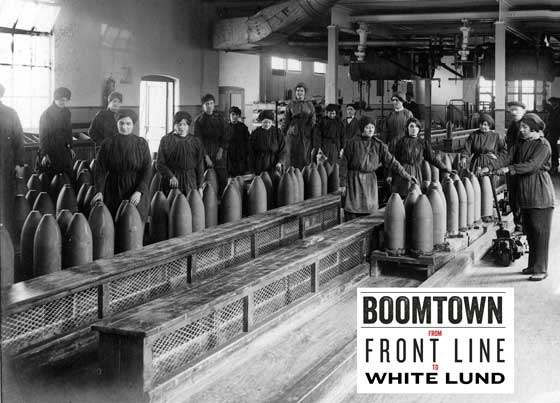The Great War Centenary
1917 - ExhibitionBoomtown - From
Front Line to White Lund
National Filling Factory Number 13 Why Here?

The Ministry of Munitions history of White Lund, written in July
1919, explained why the site was so attractive. Rail and road transport
were close by for delivering shell cases and explosives and for taking
the filled shells away for distribution.
It was close to lots of accommodation. In Lancaster there were around
500 housing standing empty and lodgings available for 9,000. In
Morecambe many boarding houses were underused as wartime holidays were
not so likely with families separated by war service. White Lund was one
of the few new munitions works that did not need to build large numbers
of hostels or houses for workers. In Gretna, Scotland, by contrast, a
whole new townscape emerged.
Local transport arrangements were made, including workmen’s trains.
There were even electric buses used for the Projectile Factory that were
called into use during the fire and explosions.
One of the challenges of the site was the water-levels. An embankment
was installed to reduce this risk especially for high tides. However,
whilst fighting the fires at White Lund, fire crews had to move their
engines from part of the site for fear of becoming stuck as the tide
came in.
Building on the site began on 2nd December 1915 and the first shell was
filled on 18th July 1916.
The buildings were joined up by 4 miles of covered ‘runways’ that
workers got to by passing through Change Houses. Fire hydrants and
sprinkler systems were installed across the site.
The water supplies for heating, sanitary, boilers and fire services came
from an artesian well sunk in the factory as well as supplies from the
Lancaster Borough Mains.
A high ‘blast wall’ was built to screen the Power and Boiler Houses in
case of explosions and the whole factory was surrounded by fencing built
to military requirements – to keep materials in and intruders out. The
site was guarded by the Works Police and soldiers of the Royal Defence
Corps.
© Images are copyright, Trustees of the King's Own Royal Regiment Museum.
You must seek permission prior to
publication of any of our images.
Only a proportion of our collections
are on display at anyone time. Certain items are on loan for display
in other institutions. An appointment is required to consult any of
our collections which are held in store.


